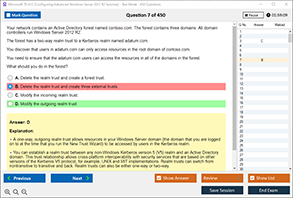Introduction
In the world of network communication, one of the most critical aspects that ensures data is transferred effectively is the sequencing function. Every time we send and receive data over the internet, we depend on numerous processes working seamlessly to ensure accuracy, reliability, and speed. The sequencing function plays a vital role in making sure that data packets arrive in the correct order and that the integrity of the data is maintained during transit.
How it works, and its relationship with various protocols. As part of this exploration, we will also discuss its importance in enhancing communication protocols, and why it is essential for smooth and error-free data transfer. This detailed breakdown is intended for IT professionals, network engineers, and anyone looking to understand how data sequencing functions work within network systems, all while keeping in mind the needs of DumpsQueen Official website's audience.
Understanding the Sequencing Function
To fully appreciate the role of the sequencing function in network communication, it is essential first to understand how data travels over a network. Data transmission over networks involves splitting the data into small packets, which are sent across various paths and may reach their destination in an unpredictable order. This is where the sequencing function steps in—its primary role is to maintain the correct order of data packets.
The Basics of Data Transmission
When data is sent over a network, it is often broken down into smaller, more manageable units called packets. Each packet contains a piece of the larger message and includes information about its sequence number. The sequence number is what allows the receiving end to correctly reconstruct the data in its original order. Without sequencing, packets could arrive in a jumbled order, rendering the data useless.
In this context, the sequencing function ensures that each packet has a unique identifier (the sequence number) that helps the receiving device to piece the data back together correctly. This is particularly important in protocols like Transmission Control Protocol (TCP), which rely on sequencing to maintain the integrity of the transmitted data.
The Role of Sequencing in Different Protocols
The sequencing function is integral to many common network communication protocols. Understanding how sequencing interacts with these protocols can offer a deeper insight into its importance in network communication.
TCP (Transmission Control Protocol)
TCP is a connection-oriented protocol that ensures reliable data transmission between devices. One of its most critical functions is sequencing. With TCP, the sequencing process ensures that the packets of data are transmitted in the correct order, even if they arrive at the destination out of order. TCP also performs other important tasks, such as error checking, retransmitting lost packets, and providing flow control, all of which contribute to the proper functioning of the sequencing process.
Every TCP packet contains a sequence number. The sender assigns a sequence number to each byte of data sent, and the receiver uses these numbers to reconstruct the original message. This allows the receiving system to handle lost or delayed packets effectively by requesting retransmission if necessary.
UDP (User Datagram Protocol)
Unlike TCP, UDP is a connectionless protocol that does not guarantee the delivery or the order of packets. While this can result in faster transmission times, it also means that the sequencing function is not applied in the same way as it is in TCP. UDP is commonly used for applications where speed is more important than reliability, such as in real-time video streaming or online gaming.
However, when sequencing is required in UDP-based communication, it is generally handled by the application layer rather than the protocol itself. Some applications that rely on UDP will implement their own sequencing mechanism to maintain the order of data.
IP (Internet Protocol)
IP is another fundamental protocol in networking that provides the routing mechanism for data packets. While IP itself does not include sequencing functionality, it works hand-in-hand with protocols like TCP to ensure that data is properly sequenced as it travels across the network. IP is primarily concerned with addressing and routing packets, but it relies on higher-level protocols to maintain data integrity, including sequencing.
How Sequencing Functions Enhance Network Communication
Sequencing is not just a technical function; it is a crucial feature that enhances the quality and efficiency of communication in a network. It ensures that data is delivered correctly, even when the network experiences issues such as packet loss, congestion, or delays. Here are some ways in which sequencing contributes to effective network communication:
Ensures Data Integrity
One of the most important functions of sequencing is maintaining the integrity of the data being transmitted. When packets arrive out of order, the sequencing function allows the receiving device to reorder them correctly. This ensures that the data is reconstructed in its original form, preserving its integrity.
Minimizes Data Loss
When using protocols like TCP, sequencing helps minimize data loss by allowing the receiving device to detect missing packets. If a packet is lost or corrupted, the receiver can request that the sender retransmit the missing data. Without sequencing, the receiving device would not know which packets were missing and would not be able to recover the lost information.
Optimizes Network Efficiency
By ensuring that data is sent in the correct order and that retransmissions only occur when necessary, sequencing optimizes network efficiency. This reduces the overhead of unnecessary retransmissions and ensures that the network is used more effectively. It also helps avoid congestion by ensuring that only relevant packets are transmitted at any given time.
Challenges of Sequencing in Network Communication
Despite its importance, sequencing in network communication is not without its challenges. Some of the common issues that can arise include:
Packet Loss
While sequencing helps recover from packet loss, it cannot completely eliminate the possibility of lost data. Network congestion, faulty hardware, or routing issues can result in packet loss, requiring retransmissions that may slow down the communication process.
Out-of-Order Delivery
In large-scale networks, especially those involving complex routing mechanisms, packets may still arrive out of order even when sequencing is applied. While sequencing can reorder these packets correctly, the time it takes to do so can delay the delivery of the complete data set, which may affect real-time applications like video streaming or VoIP.
Buffering and Latency
When packets arrive in an order that differs from the expected sequence, buffering is required to store the packets temporarily until the remaining packets arrive. This buffering process can introduce latency in the network, especially if the network conditions are poor.
Real-World Applications of Sequencing in Network Communication
Sequencing is a fundamental component in the real-world operation of many applications and services that rely on accurate data transfer. Some examples include:
Video Streaming Services
Services like YouTube, Netflix, and Zoom depend on protocols that use sequencing to ensure that video data arrives in the correct order. If video packets are received out of sequence, the video may become choppy or fail to play correctly. Sequencing helps maintain smooth video playback.
Online Gaming
Multiplayer online games require fast, real-time communication between players. Sequencing ensures that player actions, game state updates, and other data are transmitted in the correct order, allowing for a smooth gaming experience.
File Transfer Protocols
Protocols like FTP (File Transfer Protocol) and HTTP (HyperText Transfer Protocol) rely on sequencing to ensure that large files are transferred correctly. When downloading a large file, sequencing guarantees that the file is received in the correct order and can be reassembled accurately.
Conclusion
In conclusion, the sequencing function plays a critical role in network communication by ensuring that data packets are delivered in the correct order and maintaining the integrity of transmitted data. This process is vital in ensuring that modern communication protocols like TCP, UDP, and IP work effectively, enabling smooth and reliable data transfer across networks. Whether in video streaming, online gaming, or file transfers, sequencing allows us to enjoy seamless digital experiences.
As we continue to evolve in the world of networking, the importance of sequencing cannot be overstated. It ensures that data reaches its destination correctly and efficiently, paving the way for faster, more reliable communications in the future.
Free Sample Questions
1. What is the main purpose of the sequencing function in network communication?
A) To ensure that data packets are sent in parallel.
B) To reorder data packets that are received out of sequence.
C) To encrypt data before transmission.
D) To ensure network security.
Answer: B) To reorder data packets that are received out of sequence.
2. Which protocol is primarily responsible for sequencing data in network communication?
A) UDP
B) IP
C) TCP
D) FTP
Answer: C) TCP
3. Why is sequencing important in real-time applications like video streaming?
A) It improves data security.
B) It ensures that video data is played in the correct order.
C) It speeds up the transfer of data.
D) It reduces packet loss.
Answer: B) It ensures that video data is played in the correct order.




